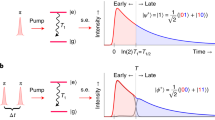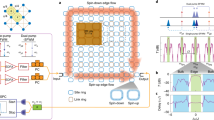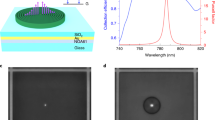Abstract
Non-classical states of light, such as entangled photon pairs and number states, are essential for fundamental tests of quantum mechanics and optical quantum technologies. The most widespread technique for creating these quantum resources is spontaneous parametric down-conversion of laser light into photon pairs1. Conservation of energy and momentum in this process, known as phase-matching, gives rise to strong correlations that are used to produce two-photon entanglement in various degrees of freedom2,3,4,5,6,7,8,9. It has been a longstanding goal in quantum optics to realize a source that can produce analogous correlations in photon triplets, but of the many approaches considered, none has been technically feasible10,11,12,13,14,15,16,17. Here we report the observation of photon triplets generated by cascaded down-conversion. Each triplet originates from a single pump photon, and therefore quantum correlations will extend over all three photons18 in a way not achievable with independently created photon pairs19. Our photon-triplet source will allow experimental interrogation of novel quantum correlations20, the generation of tripartite entanglement12,21 without post-selection and the generation of heralded entangled photon pairs suitable for linear optical quantum computing22. Two of the triplet photons have a wavelength matched for optimal transmission in optical fibres, suitable for three-party quantum communication23. Furthermore, our results open interesting regimes of non-linear optics, as we observe spontaneous down-conversion pumped by single photons, an interaction also highly relevant to optical quantum computing.
This is a preview of subscription content, access via your institution
Access options
Subscribe to this journal
Receive 51 print issues and online access
$199.00 per year
only $3.90 per issue
Buy this article
- Purchase on Springer Link
- Instant access to full article PDF
Prices may be subject to local taxes which are calculated during checkout



Similar content being viewed by others
References
Klyshko, D. N. Coherent photon decay in a nonlinear medium. JETP Lett. 6, 23–25 (1967)
Ou, Z. Y. & Mandel, L. Violation of Bell’s inequality and classical probability in a two-photon correlation experiment. Phys. Rev. Lett. 61, 50–53 (1988)
Shih, Y.-H. & Alley, C. O. New type of Einstein-Podolsky-Rosen-Bohm experiment using pairs of light quanta produced by optical parametric down conversion. Phys. Rev. Lett. 61, 2921–2924 (1988)
Rarity, J. G. et al. Two-photon interference in a Mach-Zehnder interferometer. Phys. Rev. Lett. 65, 1348–1351 (1990)
Kwiat, P. G. et al. New high-intensity source of polarization-entangled photon pairs. Phys. Rev. Lett. 75, 4337–4341 (1995)
Brendel, J., Gisin, N., Tittel, W. & Zbinden, H. Pulsed energy-time entangled twin-photon source for quantum communication. Phys. Rev. Lett. 82, 2594–2597 (1999)
Mair, A., Vaziri, A., Weihs, G. & Zeilinger, A. Entanglement of the orbital angular momentum states of photons. Nature 412, 312–316 (2001)
Barreiro, J. T., Langford, N. K., Peters, N. A. & Kwiat, P. G. Generation of hyperentangled photon pairs. Phys. Rev. Lett. 95, 260501 (2005)
Ramelow, S., Ratschbacher, L., Fedrizzi, A., Langford, N. K. & Zeilinger, A. Discrete tunable color entanglement. Phys. Rev. Lett. 103, 253601 (2009)
Rarity, J. G. & Tapster, P. R. Three-particle entanglement from entangled photon pairs and a weak coherent state. Phys. Rev. A 59, R35–R38 (1998)
Persson, J., Aichel, T., Zwiller, V., Samuelson, L. & Benson, O. Three-photon cascade from single self-assembled InP quantum dots. Phys. Rev. B 69, 233314 (2004)
Greenberger, D. M., Horne, M. A., Shimony, A. & Zeilinger, A. Bell's theorem without inequalities. Am. J. Phys. 58, 1131–1143 (1990)
Keller, T. E., Rubin, M. H., Shih, Y. & Wu, L. A. Theory of the three-photon entangled state. Phys. Rev. A 57, 2076–2079 (1998)
Gupta, S. N. Multiple photon production in electron-positron annihilation. Phys. Rev. 96, 1453 (1954)
Douady, J. & Boulanger, B. Experimental demonstration of a pure third-order optical parametric downconversion process. Opt. Lett. 29, 2794–2796 (2004)
Bencheikh, K., Gravier, F., Douady, J., Levenson, A. & Boulanger, B. Triple photons: a challenge in nonlinear and quantum optics. C. R. Phys. 8, 206–220 (2007)
Guo, H. C., Qin, Y. Q. & Tang, S. H. Parametric downconversion via cascaded optical nonlinearities in an aperiodically poled MgO:LiNbO3 superlattice. Appl. Phys. Lett. 87, 161101 (2005)
Munro, W. J. & Milburn, G. J. Characterizing Greenberger-Horne-Zeilinger correlations in nondegenerate parametric oscillation via phase measurements. Phys. Rev. Lett. 81, 4285–4288 (1998)
Zukowski, M., Zeilinger, A. & Weinfurter, H. in Fundamental Problems in Quantum Theory: A Conference Held in Honour of Professor John A. Wheeler (eds Greenberger, D. & Zeilinger, A.) 91–102 (NY Acad. Sci., 1995)
Banaszek, K. & Knight, P. L. Quantum interference in three-photon down-conversion. Phys. Rev. A 55, 2368–2375 (1997)
Zeilinger, A., Horne, M. & Greenberger, D. M. Higher-order quantum entanglement. NASA Conf. Publ. 3135, 73–81 (1992)
Browne, D. E. & Rudolph, T. Resource-efficient linear optical quantum computation. Phys. Rev. Lett. 95, 010501 (2005)
Hillery, M., Bužek, V. & Berthiaume, A. Quantum secret sharing. Phys. Rev. A 59, 1829–1834 (1999)
Burnham, D. C. & Weinberg, D. L. Observation of simultaneity in parametric production of optical photon pairs. Phys. Rev. Lett. 28, 84–87 (1970)
Kurtsiefer, C., Oberparleiter, M. & Weinfurter, H. Generation of correlated photon pairs in type-II parametric down conversion—revisited. J. Mod. Opt. 48, 1997–2007 (2001)
Fedrizzi, A., Herbst, T., Poppe, A., Jennewein, T. & Zeilinger, A. A wavelength-tunable fiber-coupled source of narrowband entangled photons. Opt. Exp. 15, 15377–15386 (2007)
Tanzilli, S. et al. Highly efficient photon-pair source using periodically poled lithium niobate waveguide. Electron. Lett. 37, 26–28 (2001)
Kurtsiefer, C., Zarda, P., Mayer, S. & Weinfurter, H. The breakdown flash of silicon avalanche photodiodes–back door for eavesdropper attacks? J. Mod. Opt. 48, 2039–2047 (2001)
Kwiat, P. G. Hyper-entangled states. J. Mod. Opt. 44, 2173–2184 (1997)
Bouwmeester, D., Pan, J.-W., Daniell, M., Weinfurter, H. & Zeilinger, A. Observation of three-photon Greenberger-Horne-Zeilinger entanglement. Phys. Rev. Lett. 82, 1345–1349 (1999)
Kiesel, N. et al. Three-photon W-state. J. Mod. Opt. 50, 1131–1138 (2003)
Acknowledgements
The authors would like to thank H. Majedi and G. Weihs for providing equipment and infrastructure for implementing the experiment. Gratefully acknowledged is the financial support by the Canadian Institute for Advanced Research, the Ontario Centres of Excellence, the Ontario Ministry of Research and Innovation, the Natural Sciences and Engineering Council of Canada and the Canadian Foundation for Innovation. S.R. acknowledges support from the FWF (CoQus).
Author information
Authors and Affiliations
Contributions
H.H. and D.R.H. performed the experiment and analysed the data; A.F. and S.R. participated in the design of the experiment; K.J.R. and T.J. contributed to the design and realization of the experiment; and all authors co-wrote the paper.
Corresponding authors
Ethics declarations
Competing interests
The authors declare no competing financial interests.
Supplementary information
Supplementary Information
This file contains Supplementary Methods and Calculations. (PDF 87 kb)
Rights and permissions
About this article
Cite this article
Hübel, H., Hamel, D., Fedrizzi, A. et al. Direct generation of photon triplets using cascaded photon-pair sources. Nature 466, 601–603 (2010). https://doi.org/10.1038/nature09175
Received:
Accepted:
Issue Date:
DOI: https://doi.org/10.1038/nature09175
This article is cited by
-
Unfolding frequency and spatial multimode through parametric amplified cascade four-mode process
Applied Physics B (2023)
-
Splitting Photons into Pair Photons to Design a High-Performance Printable Solar Cell
Silicon (2023)
-
High-performance quantum entanglement generation via cascaded second-order nonlinear processes
npj Quantum Information (2021)
-
Lost photon enhances superresolution
npj Quantum Information (2021)
-
A solid state source of photon triplets based on quantum dot molecules
Nature Communications (2017)
Comments
By submitting a comment you agree to abide by our Terms and Community Guidelines. If you find something abusive or that does not comply with our terms or guidelines please flag it as inappropriate.



